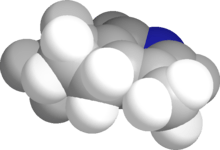Actinidine
Actinidine is a pyridine derivative found in the essential oil of valerian (Valeriana officinalis) root[2] and Actinidia polygama (silver vine). Actinidine is also a pheromone for a variety of insects. Actinidine is a cat attractant, with effects like those of nepetalactone, the active compound found in catnip.
 | |
 | |
| Names | |
|---|---|
| IUPAC name
(S)-4,7-Dimethyl-6,7-dihydro-5H-cyclopenta[c]pyridine | |
| Identifiers | |
3D model (JSmol) |
|
| 81308 | |
| ChEBI | |
| ChemSpider | |
| KEGG | |
PubChem CID |
|
CompTox Dashboard (EPA) |
|
| |
| |
| Properties | |
| C10H13N | |
| Molar mass | 147.221 g·mol−1 |
| Melting point | < 25 °C (77 °F; 298 K) |
| Boiling point | 100 to 103 °C (212 to 217 °F; 373 to 376 K) at 9 mmHg[1] |
Except where otherwise noted, data are given for materials in their standard state (at 25 °C [77 °F], 100 kPa). | |
| Infobox references | |
Biosynthesis
One of the possible biosynthesis mechanism of actinidine is that it's derived from iridoid. Actinidine is produced from Actidina polygama , which also synthesizes iridoid. An example biosynthesis of actinidine from l-citronella is shown below. [3]

References
- Sakan, Takeo; Bulletin of the Chemical Society of Japan, 1959, V32, P315-16.
- Janot MM, Guilhem J, Contz O, Venera G, Cionga E (1979). "Contribution to the study of valerian alcaloids (Valeriana officinalis, L.): actinidine and naphthyridylmethylketone, a new alkaloid (article in French)". Ann. Pharm. Fr. 37 (9–10): 413–420. PMID 547813.
- Chapter 14 - Alkaloids Derived from Terpenoids, Editor(s): Shinji Funayama, Geoffrey A. Cordell, Alkaloids, Academic Press, 2015, Pages 233-255,
This article is issued from Wikipedia. The text is licensed under Creative Commons - Attribution - Sharealike. Additional terms may apply for the media files.